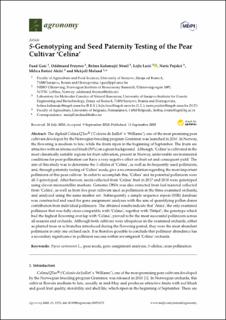| dc.description.abstract | The diploid Celina/QTee® (‘Colorée de Juillet’ × ‘Williams’), one of the most promising pear cultivars developed by the Norwegian breeding program Graminor, was launched in 2010. In Norway, the flowering is medium to late, while the fruits ripen in the beginning of September. The fruits are attractive with an intense red blush (50%) on a green background. Although, ‘Celina’ is cultivated in the most climatically suitable regions for fruit cultivation, present in Norway, unfavorable environmental conditions for pear pollination can have a very negative effect on fruit set and consequent yield. The aim of this study was to determine the S-alleles of ‘Celina’, as well as its frequently used pollinizers, and, through paternity testing of ‘Celina’ seeds, give a recommendation regarding the most important pollinizers of this pear cultivar. In order to accomplish this, ‘Celina’ and its potential pollinizers were all S-genotyped. After harvest, seeds collected from ‘Celina’ fruit in 2017 and 2018 were genotyped using eleven microsatellite markers. Genomic DNA was also extracted from leaf material collected from ‘Celina’, as well as from five pear cultivars used as pollinizers in the three examined orchards, and analyzed using the same marker set. Subsequently a simple sequence repeat (SSR) database was constructed and used for gene assignment analyses with the aim of quantifying pollen donor contribution from individual pollinizers. The obtained results indicate that ‘Anna’, the only examined pollinizer that was fully cross-compatible with ‘Celina’, together with ‘Fritjof’, the genotype which had the highest flowering overlap with ‘Celina’, proved to be the most successful pollinizers across all seasons and orchards. Although both cultivars were ubiquitous in the examined orchards, either as planted trees or as branches introduced during the flowering period, they were the most abundant pollinizers in only one orchard each. It is therefore possible to conclude that pollinizer abundance has a secondary significance in pollinizer success within investigated ‘Celina’ orchards. | en_US |

